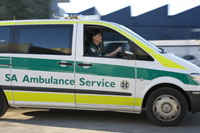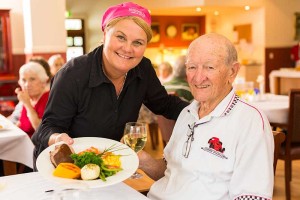
As part of our ’emergency plan’ with the nursing home it was recently decided to request an extended care paramedic if Bob ever displayed behaviours that the nursing staff could not control. This was instead of an ambulance to avoid him being sent to the hospital emergency department (ED). Little did we know that two days later Bob became violent and we needed to execute our plan.
Bob became increasingly agitated and started to grab at Mum (Jan) and myself. He became really loud and would shout out verbal rants. He then started pacing and pointing out residents and carers with an evil stare. Jan kept going into his personal space to try and calm him but she was placing herself in serious danger. I couldn’t protect her if she was between myself and Bob. It was her instinct to be the one to try and calm him at close range and was extremely brave. Bob grabbed at her and would reach for her wrists and try and wrench her arm. I jumped in to make him release his grip and he then turned on me as well. He had lost perspective that we were family and he was so frightened that he thought everyone was the enemy.
I tried to get in between Jan and Bob at every opportunity, but Jan kept walking into more trouble. I yelled at her to get out of the room so she went to grab her her bag, but turned her back on Bob. This was really bad news as he came up behind her and grabbed her again.
We spilled out into the hallways and residents were still walking around near me. I pleaded for the care staff to put them behind the fire doors, but it didn’t happen. I was so scared Bob would attack a resident I had to walk backwards in front of him and keep myself between him and the resident. This happened on at least 5 occasions and I was really getting angry that the residents welfare was not top priority. I can understand everyone was frightened, but these people are frail and can fall really easily.
The nursing home staff rang 000 and asked for the Extended Care Paramedic (ECP). We were sent a lady called Mary who was fabulous. The role she played was pivotal when Dad became violent. While I was trying to de-escalate Bob, she came in and spoke with the Registered Nurse (RN) & Carers on site. She was informed of meds administered, behaviours/triggers and briefed on the situation, so when she joined me she was fully aware on the best way to handle things.
‘Ambo Annie’ then came into the room and spoke with myself and Bob and assessed the situation. It was amazing to watch her work as she was running two mobile phones simultaneously and patched me through to two of the leading experts in dementia behaviours. DBMAS (via Alzheimers Australia) & The Rapid Access Medical Service (via Older Person’s Mental Health OPMHS) . Having this level of support and expertise was invaluable.
In the heat of the battle ‘Ambo Annie’ would talk on my behalf to one service and hand me the other phone so I could talk with the other service. My role was keep the residents safe and also Bob. Mary knew where the situation was heading and was able to setup all the information and services I needed while I grappled with Bob. This way I had someone in my ear trying to help me control Bob’s behaviour and the other one was giving me advice on whether to go to hospital, determine which hospital would be best, and all the outcomes that will occur. The scene was not unlike a hostage/terrorist situation and was extremely ‘amped up’. As I was the person who knew Bob’s behaviour the most I was ultimately in charge by default, and was a completely surreal situation as I had to make the decisions on the run.
Eventually we decided we were “outta control” and had to get Bob to the hospital. Mary called the ambo team for me and prepared for their entry. ‘Ambo Annie’ acted as a ‘link person’ which allowed me to keep talking with Bob without having to step away and explain things to ambos and nurses etc.She had access to police backup but chose to not engage them for fear of heavy handed restraint which could further escalate the situation and frighten Bob.I was so pleased that ‘Ambo Annie’ understood dementia and had Bob’s point of view and welfare ‘front of mind’ at all times. We formed a bond as we worked and we became in synch with each other very quickly. I could hear ‘Ambo Annie’ on the phone totally supporting me as she explained that I was doing the right things and covering all the basics.
When the ambulance arrived they brought the stretcher into the nursing home so they could transport Bob to hospital. He was refusing all medications so we had very little hope of a smooth transition. It was decided that it was too dangerous to give Bob an injected sedative so we had to use a nostril spray that absorbs into bloodstream within 10 minutes. Getting the spray in was the hard part and what followed was very traumatic.
The ambos set up a special net on the stretcher which is like a heavy mesh blanket with some arm holes. It is designed to pin the patient down and hold them securely if they are thrashing and struggling. We then moved into Bob’s room to administer the spray by coaxing him into his bed. We struggled for an hour as we tried many methods to get him in a position to give him the spray. Each time ‘Ambo Annie’ went to give the spray he would release an arm and try and hit her. I then decided the best action was to throw his doona over his chest sideways and pin his arms. This was really distressing for Bob as I had to dive on him with my bodyweight and hold his head still with one arm while the spray went in so he could not bite us.
All 4 of of us jumped backwards after the first spray and Bob was in a rage and understandably so. He thrashed about the room and pushed over furniture etc. We had to do this a second time and it was not easy. after 20 minutes Bob became drowsy and calmer and we eventually coaxed him onto the stretcher bed with some real difficulty. The ambo placed the stretcher bed next to his normal bed but the opposite way with his pillow up the other end. This simple mistake caused major confusion for Bob as it was not his normal sleeping position so was reluctant to lay down. Eventually we turned him around and strapped him down.
‘Ambo Annie’ stayed with me every step of the way and would not leave my side, which was really comforting. When transporting Bob to the hospital Annie switched places with one of the ambos which allowed Bob to have continuous treatment with the one person. The ambo drove the other car to the hospital.
On arrival at the the hospital ‘Ambo Annie’ took control and delivered one of the most composed and succinct speeches I have heard. She calmly gathered the medical team and methodically went through step by step every important detail they needed to know to get Bob sedated and looked after medically. She was so composed and calm and hit every single point that I needed her to get across, to ensure the best plan of action.
INFO ON EXTENDED CARE PARAMEDICS:
The extended care paramedic (ECP) service allows patients to be treated at home or in their home surrounds, without being transported to a hospital emergency department if it is not necessary. In this case things escalated and we needed an ambulance and the extra help.
An ECP is an SA Ambulance Service intensive care paramedic who has undergone intensive skills enhancement and training. ECPs can treat patients for a range of common medical issues and refer patients to other health providers such as GPs if needed.
With this service, an ECP assesses the patient’s requirements through phone consultation and dispatches an ECP single responder in an ambulance response vehicle as opposed to a traditional stretcher-carrying ambulance. The service can be requested when dialing 000.
For more information on this service click the following link:
http://www.saambulance.com.au/LinkClick.aspx?fileticket=7dKFTy8RTL0%3d&tabid=82















 Facebook
Facebook Twitter
Twitter LinkedIn
LinkedIn